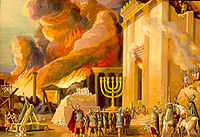Fast Days: Difference between revisions
From Halachipedia
No edit summary |
No edit summary |
||
| Line 4: | Line 4: | ||
==Tzom Gedalya== | ==Tzom Gedalya== | ||
# Tzom Gedalya is observed on the 3rd of Tishri. <ref> Chazon Ovadia, Laws of the Four Fasts, Halacha 3 </ref> | # Tzom Gedalya is observed on the 3rd of Tishri. <ref> Chazon Ovadia, Laws of the Four Fasts, Halacha 3 </ref> | ||
# Tzom Gedalya commemorates the death of Gedalya Ben Achikam. <ref> Chazon Ovadia, Laws of the Four Fasts, Halacha 3 </ref> | # Tzom Gedalya commemorates the death of Gedalya Ben Achikam and the extinguishing of the spark of Yisrael causing the exile. <ref> Rambam (Taniyot 5:2), Chazon Ovadia, Laws of the Four Fasts, Halacha 3 </ref> | ||
==Asara BeTevet== | ==Asara BeTevet== | ||
# Asara BeTevet commemorates the tragedy of Nebuchadnezzar's laying siege on the city of Jerusalem. <ref> Chazon Ovadia, Laws of the Four Fasts, Halacha 4 </ref> | # Asara BeTevet commemorates the tragedy of Nebuchadnezzar's laying siege on the city of Jerusalem. <ref> Rambam (Taniyot 5:2), Chazon Ovadia, Laws of the Four Fasts, Halacha 4 </ref> | ||
==Shiva Asar BeTamuz== | ==Shiva Asar BeTamuz== | ||
# Shiva Asar BeTamuz commemorates 5 things: 1) The Luchot were broken. 2) The Korban Tamid in the 1st Bet Hamikdash was abolished. 3) In the 2nd Bet Hamikdash destruction, the city of Jerusalem was breached. 4) The Torah was burned by Apostomus. 5) An idol was put in the Bet Hamikdash. <ref> Chazon Ovadia, Laws of the Four Fasts, Halacha 1 </ref> | # Shiva Asar BeTamuz commemorates 5 things: 1) The Luchot were broken. 2) The Korban Tamid in the 1st Bet Hamikdash was abolished. 3) In the 2nd Bet Hamikdash destruction, the city of Jerusalem was breached. 4) The Torah was burned by Apostomus. 5) An idol was put in the Bet Hamikdash. <ref>Rambam (Taniyot 5:2), Chazon Ovadia, Laws of the Four Fasts, Halacha 1 </ref> | ||
# The fast of Shiva Asar BeTamuz is observed on the seventeenth of Tamuz. <ref>Tur 549:2 explains that on the ninth of Tamuz the wall of Yerushalyim was broken by the first Bet HaMikdash, however, nowadays we fast on the seventeenth of Tamuz which was when the wall of Yerushalyim was broken by the second Bet HaMikdash. This codified as halacha by the Rambam (Taniot 5:2-3), S”A 549:1, Mishna Brurah 549:1, and Yalkut Yosef (Moadim pg 527). </ref> | |||
==Tisha BeAv== | ==Tisha BeAv== | ||
# Please see the separate article for [[Tisha BeAv]]. | # Please see the separate article for [[Tisha BeAv]]. | ||
Revision as of 14:50, 3 January 2012
All of Yisrael fasts on the four fast days mentioned by the prophets which are: Tzom Gedalya (the third of Tishrei), Asara BeTevet (tenth of Tevet), Shiva Asar BeTamuz (seventeenth of Tamuz), and Tisha BeAv (ninth of Av). [1] The significance and background of these fasts are explained below. The first three are discussed in this article. For the other fasts please see the following links: Tisha BeAv, Tanit Ester, Tanit Bechorim. Another related page is Commemoration of the Destruction of the Temple (Zecher LeChurban).
Tzom Gedalya
- Tzom Gedalya is observed on the 3rd of Tishri. [2]
- Tzom Gedalya commemorates the death of Gedalya Ben Achikam and the extinguishing of the spark of Yisrael causing the exile. [3]
Asara BeTevet
- Asara BeTevet commemorates the tragedy of Nebuchadnezzar's laying siege on the city of Jerusalem. [4]
Shiva Asar BeTamuz
- Shiva Asar BeTamuz commemorates 5 things: 1) The Luchot were broken. 2) The Korban Tamid in the 1st Bet Hamikdash was abolished. 3) In the 2nd Bet Hamikdash destruction, the city of Jerusalem was breached. 4) The Torah was burned by Apostomus. 5) An idol was put in the Bet Hamikdash. [5]
- The fast of Shiva Asar BeTamuz is observed on the seventeenth of Tamuz. [6]
Tisha BeAv
- Please see the separate article for Tisha BeAv.
Communal fast days
Individual fast days
Related Pages
References
- ↑ The prophet Zechariyah (8:19) stated that in the future the fast of the fourth, fifth, seventh, and tenth will become days of happiness for the Jews. In Gemara Rosh Hashana 18b, Rabbi Akiva explains that number in the pasuk refers to the number of the month. Thus, the fast of fourth is the ninth of Tamuz, the fifth is the ninth of Av, the seventh is the third of Tishrei (fast of Gedalyah), and tenth is tenth of Tevet. The Tur 549:1 and Rambam (Taniot 5:4) rule like Rabbi Akiva. Tur 549:2 explains that on the ninth of Tamuz the wall of Yerushalyim was broken by the first Bet HaMikdash, however, nowadays we fast on the seventeenth of Tamuz when the wall of Yerushalyim was broken by the second Bet HaMikdash. These four fasts are codified as halacha by the Rambam (Taniot 5:2-3), S”A 549:1, Mishna Brurah 549:1, and Yalkut Yosef (Moadim pg 527).
- ↑ Chazon Ovadia, Laws of the Four Fasts, Halacha 3
- ↑ Rambam (Taniyot 5:2), Chazon Ovadia, Laws of the Four Fasts, Halacha 3
- ↑ Rambam (Taniyot 5:2), Chazon Ovadia, Laws of the Four Fasts, Halacha 4
- ↑ Rambam (Taniyot 5:2), Chazon Ovadia, Laws of the Four Fasts, Halacha 1
- ↑ Tur 549:2 explains that on the ninth of Tamuz the wall of Yerushalyim was broken by the first Bet HaMikdash, however, nowadays we fast on the seventeenth of Tamuz which was when the wall of Yerushalyim was broken by the second Bet HaMikdash. This codified as halacha by the Rambam (Taniot 5:2-3), S”A 549:1, Mishna Brurah 549:1, and Yalkut Yosef (Moadim pg 527).
